
HOSTS- Jeremy Burns, Matthew Scott Phillips
TYPE- Theory
DURATION- 79:14
BUMPER MUSIC- "This Is Our Quest" (Area 47 Music)
ANNOUNCER- Mike Cunliffe
At this point, we've discussed the two most common diatonic 7th chords: V7 and II7. Now, we will discuss "The Others". These are the VII7, IV7, VI7, I7 and III7 chords.
We will take a little time with each of these, give them a listen, discuss the way they sound and briefly discuss their functionality. Just because these are a little less common, that's no reason to not bring them up because they are often featured in great music!
VOICE LEADING CONSIDERATIONS
The voice leading considerations for the 7th chords are the same as they are for their complimentary
DIATONIC TRIADS.
-The 7th of the chord must resolve down a step.
-Because there are 4 chord members to the 7th chord, there is rarely a need for doubling in 4 part textures. If you decide to double a chord member, don't make it the LEADING TONE of the scale. Otherwise, you may be subject to parallel octaves.
-If you decide to omit a chord member, the 5th is your best bet. The ROOT gives you the chord name and function. The 3rd gives the chord it's quality (major or minor). And, of coarse, without the 7th, it would cease to be a 7th chord.
-The same rules apply to the inversions of these chords.
-In jazz and pop music, these rules aren't as widely observed. In the7th chords aren't considered as dissonant as they are in classical music.
*As you listen to this episode, you will hear us reference SCALE DEGREES (1, 2, 3, 4, 5, etc...)
and CHORD MEMBERS (root, 3rd, 5th, 7th, etc...).
Be sure to not confuse them!
The VII7 chord takes on different qualities in different keys.
In MAJOR keys (we'll use C major) the VII7 chord is a HALF DIMINISHED SEVENTH chord.
MAJOR KEYS
vii 7
ø
Below, we have a viiv7 in 1st inversion (6/5). It is a B HALF DIMINISHED (ø) 7 chord. Because it is in 1st inversion, we have the 3rd (D) in the bass. The ROOT (B) lies in the tenor voice, the 5th (F) in the alto and the 7th (A) in the soprano.
There are no accidentals or foreign notes, so this chord is DIATONIC.
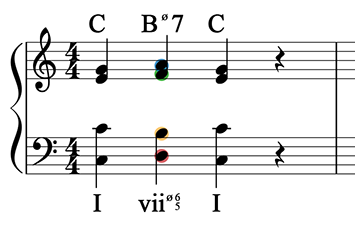
In MINOR keys (we'll use C minor) the VII7 chord is a MAJOR MINOR 7 chord.
MINOR KEYS
(NATURAL MINOR)
VII7
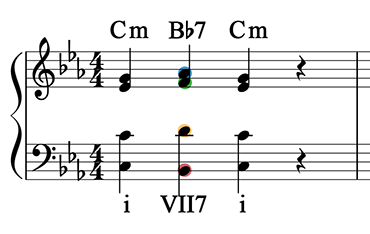
On occasion, in MINOR keys, the seventh scale degree will be sharpened. This is done when using the HARMONIC MINOR scale. This will result in a FULLY DIMINISHED SEVEN CHORD (º).
MINOR KEYS
(HARMONIC MINOR)
vii˚7

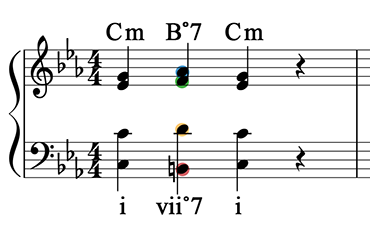
Like the IV triad, the IV7 chord takes on different qualities in different keys.
In MAJOR keys the IV7 chord is a
MAJOR SEVENTH chord.
MAJOR KEYS
IVM7
In MINOR keys the IV7 chord is a
MINOR SEVENTH chord.
MINOR KEYS
ivm7
-The SUBDOMINANT (IV) chord, like the triad, want’s to go to V or vii•. It will sometimes pass through a II first.
In MAJOR keys the VI7 chord is a
MINOR 7 chord.
MAJOR KEYS
vim7
In MINOR keys the VI7 chord is a
MAJOR 7 chord.
MINOR KEYS
VIM7
-The SUBMEDIANT 7th chord (VI7), like the triad, wants to go to a PREDOMINANT chord, such as II or IV.
-INVERSIONS can come in handy because moving from ROOT POSITION VI to ROOT POSITION V, parallel octaves can occur.
In MAJOR keys the I7 chord is a
MAJOR 7 chord.
MAJOR KEYS
IM7
In MINOR keys the I7 chord is a
MINOR 7 chord.
MINOR KEYS
im7
-Like the I triad, the I7 chord can go virtually anywhere, but tends to go to IV, II or VI.
-Adding that 7th to a I chord robs it of it’s stability a bit. The TONIC flavor is marred somewhat. This is not a problem in jazz or pop music.
In MAJOR keys the III7 chord is a
MINOR 7 chord.
MAJOR KEYS
iiim7
In MINOR keys the III7 chord is a
MAJOR 7 chord.
MINOR KEYS
IIIM7
-The MEDIANT wants to go to a PREDOMINANT or back to the TONIC.
-Sometime it will act as a substitution for I. Or it may move to and from I, in succession.
-It will often to go to VI, but will sometimes move to IV fairly smoothly.
-The 7th chord QUALITY is inconsequential to the FUNCTION of the chord. These chords want to move in the same directions as do their DIATONIC TRIAD counterparts.
-The same voice leading rules apply to the 7th chords as do their TRIAD counterparts, in harmonic progression.
-The use of the HARMONIC MINOR scale in MINOR keys can alter the quality of the 7th chords. When using the NATURAL MINOR scale, for example, the VII7 chord is a MAJOR MINOR 7 chord (Mm7). When using the HARMONIC MINOR scale, the VII7 chord becomes a FULLY DIMINISHED 7 chord (˚7).
-The FULLY DIMINISHED 7th chord is said to be INTERVALLIC or SYMMETRICAL. This chord consists of four MINOR 3rd intervals and land on the ROOT. 12 notes are divided, equally and symmetrically, into 4.
